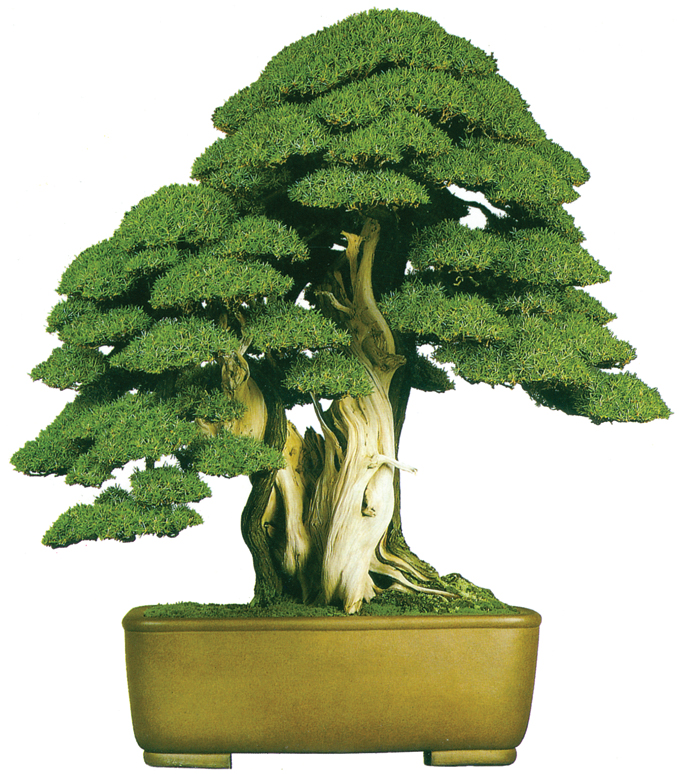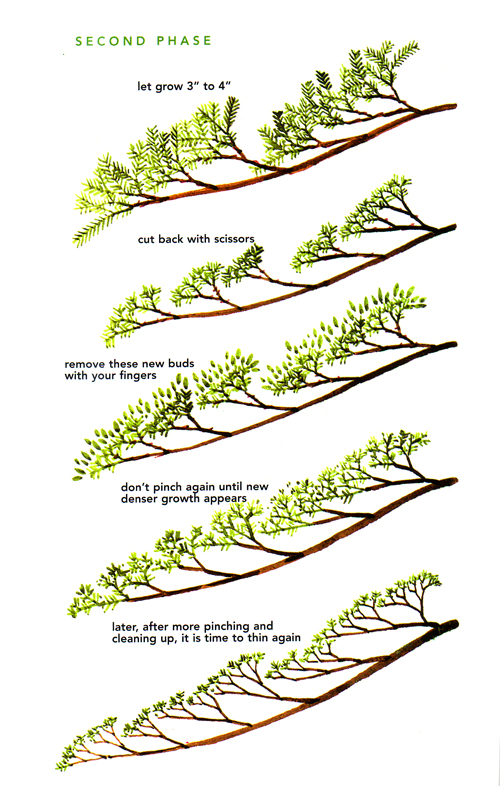 This isn’t the first time we’ve featured this famous bonsai that originally appeared on the cover of Bonsai Today 63 and later in our Juniper book. I think it’s appropriate here for a couple reasons: it’s by Shinji Suzuki, Michael Hagedorn’s bonsai sensei (Michael provided the fuel for this post and our previous post) and it’s a needle type juniper, which provides a contrast to scale type junipers when it comes to controlling new growth. We can assume that Mr. Suzuki trimmed rather than pinched in creating such a profusion of dense foliage pads.
This isn’t the first time we’ve featured this famous bonsai that originally appeared on the cover of Bonsai Today 63 and later in our Juniper book. I think it’s appropriate here for a couple reasons: it’s by Shinji Suzuki, Michael Hagedorn’s bonsai sensei (Michael provided the fuel for this post and our previous post) and it’s a needle type juniper, which provides a contrast to scale type junipers when it comes to controlling new growth. We can assume that Mr. Suzuki trimmed rather than pinched in creating such a profusion of dense foliage pads.
Continuing where we left off
Rather than try to answer all the comments that we’ve received (so far) on our last post, Pinch! Don’t Pinch! I thought it might be helpful to continue the discussion with another post.
A few random observations
There’s so much information about pinching and trimming juniper bonsai that it is easy to become completely overwhelmed. After a somewhat cursory trip through some of the information, a few observations stand out:
1. For our purposes here, pinching or not pinching is primarily about controlling new growth (see 5. below for other reasons why you might or might not pinch).
2. Michael Hagedorn’s posting Never Pinch Junipers is excellent and provides much of what you need to know about the topic.
3. Often when people say pinching they mean plucking; pulling off new growth rather than pinching using your finger or thumb nails. A variation on plucking is twisting off new buds. Another variation is using tweezers to pull off new growth.
4. There are two distinct types of junipers, needle junipers and scale junipers. They are treated differently when it comes to controlling new growth (see Never Pinch Junipers for the best explanation).
5. Pinching or plucking (or using scissors instead) is used for a number of tasks. Here are five that pop to mind: developing ramification, energy balancing, cleaning out unwanted new growth (for example in branch junctions) controlling new growth to maintain a tree’s silhouette and encouraging foliage density.
6. I think it’s especially the ‘controlling new growth’ uses of pinching that Michael Hagedorn and others object to. Too much pinching to maintain a juniper’s silhouette and promote density can weaken or kill branches and even whole trees.
Some useful links
Rather then go into more elaborate detail, here are some links you might find helpful, provided you don’t mind a little information overload.
Our previous post (including the comments), Pinch! Don’t Pinch!
The above mention Never Pinch Junipers by Michael Hagedorn that set this discussion in motion and may be the simplest explanation you’ll find on how to control growth on scale and needle junipers.
An earlier post of Michael’s on Crataegus Bonsai that I can’t seem to find. However, some of what Michael had to say on the topic appeared on Bonsai Bark way back in 2010.
Other Bonsai Bark posts on the subject. Rather than list them all, I simply searched ‘pinching.’ Some of these are about junipers and some aren’t.
Bonsai Today Masters’ Series Juniper book.
Numerous articles in back issues of Bonsai Today magazine.
A short and sweet illustrated discussion of pinching on Bonsai Primer.
Google search of ‘pinching juniper bonsai.’ Be wary. Anyone can post pretty much anything on almost any topic. Still, if you’re a research junkie you might find some useful stuff (but then, if you’re a research junkie, you don’t need me to help you search google).
 Pinching for ramification (branch development). From our Juniper book.
Pinching for ramification (branch development). From our Juniper book.
Very nice article. Just came across this today. i’m a begginner in bonsai and this is truly v v helpful. thank you so much and keep posting such informative articles.
Michael Hagedorn’s article caused much discussion via an email list used by one of the local societies. I really think a couple of things are overlooked in the discussion. I took his comments to mean that _over_ pinching was a problem – and that is a risk with any genera. People get caught up in rules – especially for things that they don’t understand. I once had someone ask how much water I gave to an orchid. It is as though there is some mystery about water – and that you should prescribe it in ounces. There was a puzzled look when I said – until it runs through the bottom of the pot. Bonsai is two art forms – horticulture and design. Many who practice the art – are only good at one half of the equation.
No matter what you grow – you have to understand it needs and how it grows. How can you adequately design a plant if you don’t know the difference between alternating or opposing bud growth patterns? Pinching is really the art of balancing growth. If a plant sends most of the growth energy to the top and branch tips, then we must balance that energy so that the lower (or inner) branches don’t weaken or die. Some genera are more aggressive about top growth than others and require more attention to that area. Then there are seasonal issues. Is pruning/pinching harmful when the tree is storing energy for the next growing season? I think that late season pruning is probably counterproductive. If you really want to get puzzled looks, start discussing root growth. Find Brent Walston’s on fall repotting. For many years I have used a balanced fertilizer as opposed to a low nitrogen fertilizer in the fall. I tend to agree – there is more happening with the roots late in the year. What about the texts that prescribed larger particle size in the bottom of the pot, medium in the middle area and fine on top? A Google search will probably turn up a dozen articles or discussions of perched water when you use this strategy. Rules are not always our best friend.
When this came up, I spent the time to find the 1964 book by Kyuzo Murata. When I started bonsai we had nearly no good guidance in English – Murata’s book was a blessing. He says to pinch the scale leafed junipers as growth needs to be contained. But it is clear that he means this to be used to retain shape and to balance growth. I cannot imagine that Michael Hagedorn is suggesting anything else.
One last thing… I am willing to bet that more junipers are lost to spider mites than to over pinching. What about inadequate sun?
Thanks Greg,
Food for thought. And agreed about inadequate sun. Same goes for larches; they require full sun for optimal health.
Spider mites can be a problem with junipers for sure, especially when they are otherwise stressed, like when people try to grow them indoors or with lack of sun or generally poor care. Healthy junipers growing outdoors with plenty of sun and proper care usually can resist mites.